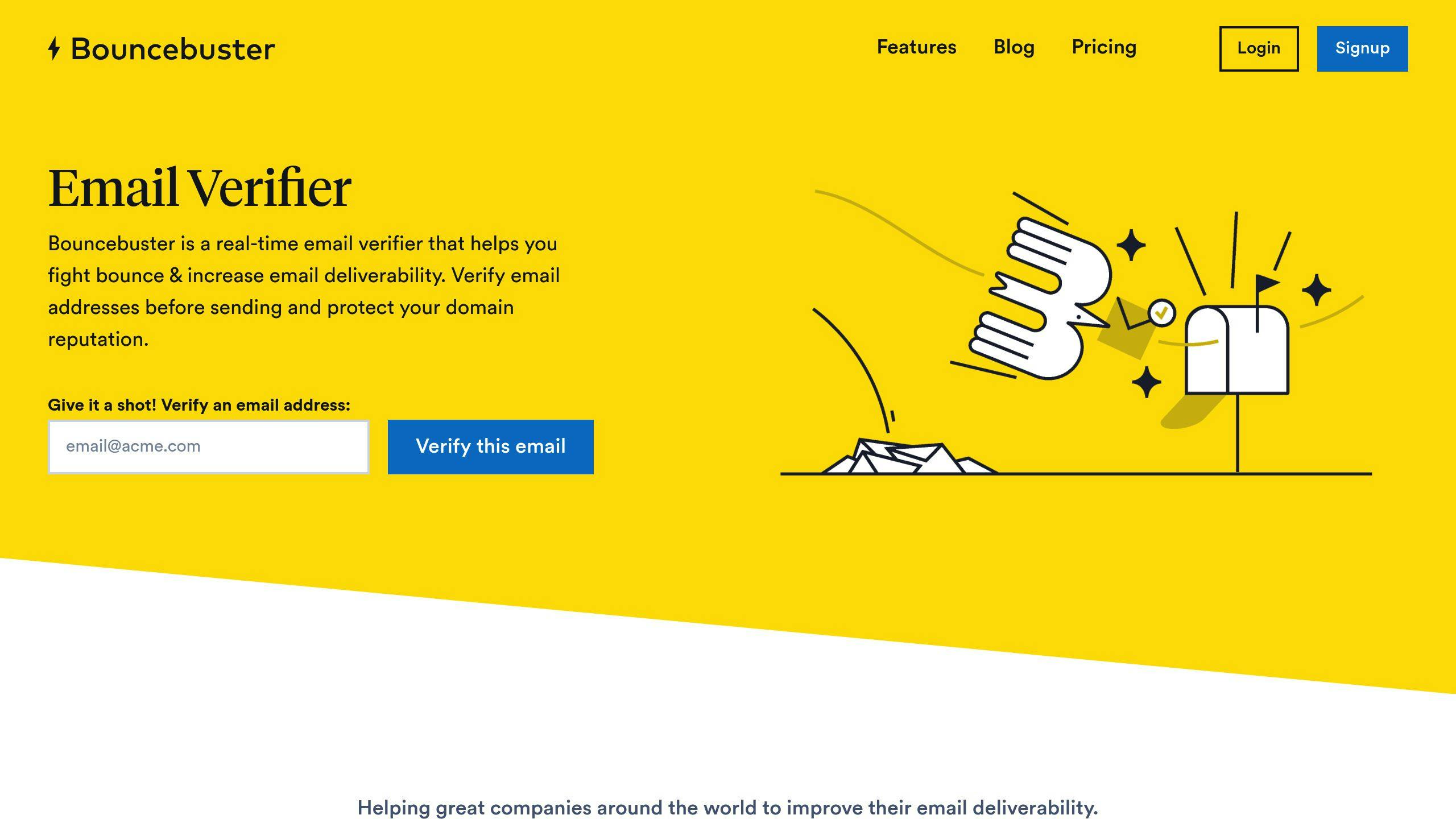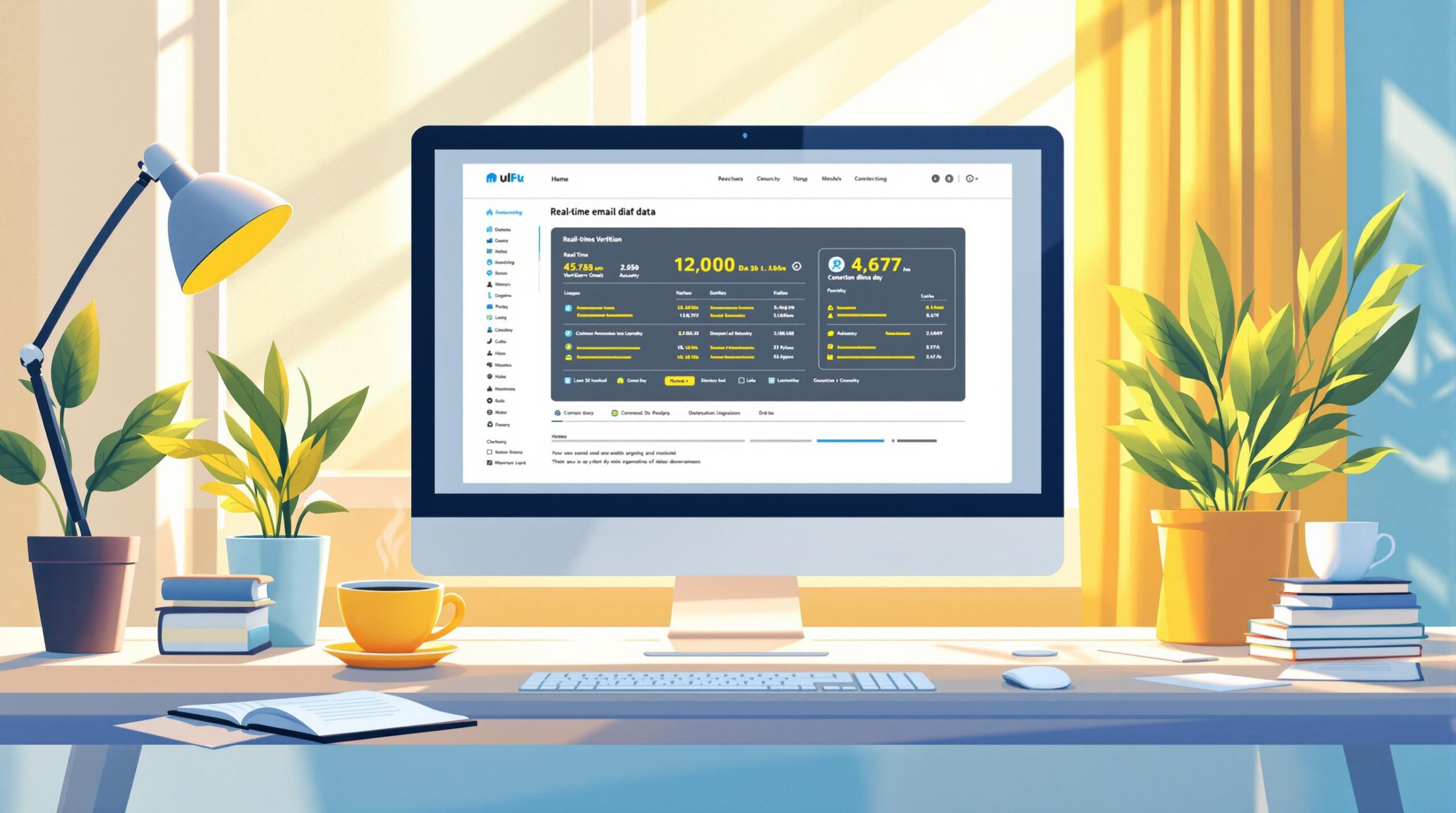Real-time email verification ensures accurate lead data by validating emails as they’re entered. This process helps businesses reduce bounce rates, improve deliverability, and protect sender reputation. Key benefits include:
- Improved Deliverability: Verified emails lead to a 95%+ delivery rate.
- Cost Savings: Avoid marketing waste by cutting invalid leads.
- Higher Engagement: Quality leads result in 20%+ better engagement.
- Streamlined Workflows: Integrate with CRMs for automated lead management.
How It Works:
- Syntax Check: Validates email format.
- Domain Verification: Confirms the domain can receive emails.
- Mailbox Confirmation: Ensures the specific address exists.
Real-time verification is ideal for lead forms, while batch methods clean existing lists. Tools like Bouncebuster integrate seamlessly with CRMs to automate the process, boost lead quality, and save costs. Start by setting up API-based verification for instant, reliable results.
Email Verification API for Real-Time Verification
Email Verification Process
Real-time email verification uses a detailed, multi-step process to check email addresses during lead capture. This approach helps maintain clean data while keeping the user experience smooth.
How Verification Works
The process involves three main steps to confirm if an email address is valid and can receive messages:
| Verification Stage | What It Checks | Why It Matters |
|---|---|---|
| Syntax Check | Email format, special characters, length | Catches basic formatting mistakes |
| Domain Verification | Domain validity and ability to receive email | Ensures the domain can accept emails |
| Mailbox Confirmation | SMTP connection, catch-all status | Confirms the specific address exists |
By filtering out invalid emails early, this process improves lead quality and streamlines workflows.
Real-Time vs Batch Methods
Real-time verification stops invalid data at the point of entry, saving time on cleanups and ensuring better data accuracy. Batch verification, meanwhile, is better suited for reviewing existing email lists or processing large imports.
Advantages of Real-Time Verification:
- Provides instant feedback during form submissions
- Blocks invalid data before it enters your system
- Reduces the need for later corrections
- Helps maintain consistent data quality
For real-time checks, API-based methods are a smoother alternative to One-Time Password (OTP) verification. APIs work quietly in the background, while OTPs may lead to user drop-off because of the extra step required [1].
Real-time validation is particularly useful for businesses that rely on forms and landing pages to gather leads. To maximize results, many organizations use both methods: real-time checks for new leads and batch verification to keep existing databases clean.
Now that you understand the process, the next step is integrating these tools into your CRM to streamline lead management.
CRM Integration Guide
Adding email verification to your CRM requires thoughtful planning to ensure smooth integration and effective lead management. Today’s CRM systems provide several options for incorporating email verification features.
API vs Native Tools
Deciding between API integration and native CRM tools can influence how well your verification process fits into your workflow.
| Integration Type | Benefits | Drawbacks |
|---|---|---|
| API Integration | Real-time checks, Custom workflows, Higher accuracy | Needs technical skills, Longer setup |
| Native CRM Tools | Easy setup, Built-in interface, No coding required | Less customization, Basic features |
Businesses using API-based verification have seen a 215% boost in qualified leads compared to those relying on native tools [1]. For advanced real-time verification, solutions like Bouncebuster are often recommended for seamless CRM integration.
Bouncebuster CRM Setup

Bouncebuster can improve your CRM’s lead management by offering tools that simplify email verification workflows:
- Bulk verification: Cleans up your existing contact lists to ensure data accuracy.
- Manual verification: Allows you to validate specific leads directly within the CRM.
- REST API integration: Automates verification during the lead capture process.
- Upcoming integrations: Planned compatibility with Salesforce and HubSpot will make it easier to use on these platforms.
These features not only maintain clean databases but also improve lead segmentation and streamline workflows. Setting up Bouncebuster in your CRM is designed to be straightforward and efficient.
Setup Instructions
To get started, generate an API key through your verification service dashboard. Configure webhooks for real-time verification and install any required components in your CRM system. Set up error handling and notifications to ensure everything runs smoothly.
Before rolling it out fully, test the integration using sample email addresses in various scenarios. Adjust your settings based on the results to optimize performance. Finally, configure your CRM to automatically tag and segment leads based on email validity. This method has helped businesses cut down marketing waste by up to 23% [2].
sbb-itb-f42cab2
Lead Form Verification
Getting lead form verification right is essential for keeping your data clean and boosting conversion rates. Modern forms blend a smooth user experience with strong validation measures to make sure email addresses are accurate.
Form Design Tips
Designing forms for effective email validation requires balancing ease of use with security. The goal is to make verification feel natural for the user while ensuring reliable data.
| Design Element | Implementation | Impact |
|---|---|---|
| Real-time Validation & Formatting | Use API-based email verification and auto-formatting during submission | Prevents errors and reduces drop-offs |
| Visual Indicators | Apply color-coded cues (e.g., green for valid, red for invalid) | Builds user trust and confidence |
| Suggestion System | Offer domain corrections and alternatives | Quickly catches and fixes typos |
To maximize results, position email verification fields early in your forms. This strategy improves completion rates by giving users immediate feedback. Services like Bouncebuster can validate email addresses in real-time as users type, offering a smooth and efficient experience tailored for lead capture.
Error Management
Handling errors well is just as important as designing the form itself. Clear and actionable error management can make the difference between a completed form and an abandoned one.
Clear Error Messages
- Highlight common issues, like missing ‘@’ symbols, and suggest fixes for invalid domains.
- Provide straightforward guidance to help users correct mistakes.
Progressive Validation
Use a step-by-step validation process to catch errors at different points without disrupting the user experience. Research shows that implementing this approach can lower form abandonment rates by up to 23% [1].
Smart Recovery Options
Include features like auto-correcting domains and offering valid suggestions to steer users toward successfully completing the form.
Once your forms are optimized for email verification, the next step is to monitor their performance and refine your lead management strategy accordingly.
Performance Tracking
Measuring how well your email verification efforts are working is essential for improving your lead management process. By keeping an eye on key performance indicators (KPIs), you can better understand the impact of email verification and its return on investment (ROI).
Key Metrics to Monitor
Here are three metrics that play a major role in lead quality and campaign success:
| Metric Type | Key Indicators | Target Goals |
|---|---|---|
| Delivery Health | Bounce Rate < 2% | Protect sender reputation |
| Email Performance | Delivery Rate > 95% | Ensure emails reach inboxes |
| Lead Quality | Engagement Rate > 25% | Maintain a high-quality list |
Using real-time verification tools can help you block invalid emails before they even make it into your database. This keeps your lead data accurate and reliable.
Balancing Costs and Benefits
When calculating the ROI of email verification, focus on these factors:
| Factor & Benefit | Impact |
|---|---|
| Verification Service: Fewer bounces | Save $0.25–$0.50 per avoided bounce |
| API Integration: Better deliverability | 15–20% boost in inbox placement |
| Implementation: Higher engagement | 10–25% increase in open rates |
For example, a company that started using real-time verification saw an 80% drop in bounces, saved $2,000 each month, and boosted conversions by 20%. These results show how email verification can dramatically improve lead management and campaign outcomes.
"High-quality data is crucial for effective email verification. Inaccurate or outdated data can lead to false positives or false negatives, undermining the effectiveness of the verification process."
To stay on top of things, review your metrics every month. Sync these verification metrics with your CRM system for a complete view of lead quality and campaign performance. This integration supports real-time decisions and quicker adjustments to your lead management strategies.
Conclusion
Main Points
Real-time email verification has become a game-changer for managing leads effectively, offering clear improvements in business performance. Data reveals that keeping email lists clean significantly boosts campaign success. For example, verified lists often see open rates between 33-69%, compared to just 1-5% for unverified ones.
| Area | Benefits of Real-Time Verification |
|---|---|
| List Quality & Health | 95% Deliverability, 30% Fewer Annual Turnovers |
| Engagement | 20% Average Increase in List Engagement |
These results make integrating real-time email verification an essential move for businesses aiming to refine their lead management strategies.
Getting Started
Here’s how to get started with real-time email verification:
- Pick a reliable tool: Look for one that works seamlessly with your CRM.
- Integrate verification points: Add it to lead capture forms and set up regular database checks.
- Track your progress: Aim for deliverability above 95% and bounce rates under 2% to stay aligned with industry standards.
Consistently monitoring your performance will ensure your verification process stays effective. With proper setup, you can expect better deliverability within the first month, leading to stronger engagement and higher conversions.
For businesses looking to upgrade their lead management, tools that integrate with CRM systems can help cut marketing costs and improve campaign outcomes [1][2].



